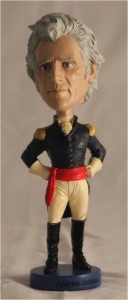 It’s hard to know what to leave in and what to take out when you teach about Andrew Jackson. Especially when the people you’re teaching are only ten years old.
It’s hard to know what to leave in and what to take out when you teach about Andrew Jackson. Especially when the people you’re teaching are only ten years old.
That’s my annual dilemma as a volunteer instructor at Jere Whitson Elementary School. Earlier this spring, I was helping prepare the fourth graders for their upcoming field trip to the Hermitage. Naturally, I wanted them to know a lot about the first U.S. President from Tennessee.
So I began with the good stuff.
I tell them that Jackson was the first President to come from humble beginnings. Born in a log cabin in 1767 to a widowed mother with two other young sons, Jackson learned to make his way in the world with his wits and his fists. He showed his legendary spunk at age 14during the Revolutionary War, when his refusal to polish a British officer’s boots provoked the man into slashing him across the face with his sword. Jackson proudly bore that scar for the rest of his life.
Fourth graders like that story. They also like hearing how Jackson rescued an orphaned Creek Indian child during the Battle of Horseshoe Bend in 1814 and sent him back to the Hermitage to raise as his own son. And how he earned the nickname “Old Hickory” during the Battle of New Orleans the following year.
They’re intrigued by the bullet Jackson carried in his lung for almost forty years following a deadly duel with Charles Dickinson. And by the fact that he married Rachel Donelson– the love of his life—twice, after learning that she wasn’t legally divorced at their first wedding. The students mourn with a heartbroken Andrew as he buries Rachel on the Christmas Eve following his election, dressed in the ball gown she was to wear to the inauguration.
I stress that Andrew Jackson was a defender of the Union, a symbol of democracy, the champion of the common man. What other President has ever had thousands of well-wishers climb through the White House windows, stand on the furniture, spit tobacco juice on the carpets and quickly devour a 1,400-pound wheel of cheese to celebrate his inauguration?
But you can’t be truthful about Jackson without talking about the negative stuff, too.
His fiery temper. His propensity to gamble vast quantities of money on horse races, cockfights and card games. His eagerness to replace experienced government workers who disagreed with him with friends who did.
Then there was the fact that Jackson was a slaveholder. He built the Hermitage, enjoyed a lavish lifestyle there and made his fortune on the forced labor of the more than 150 enslaved men, women and children he owned. He once offered a generous reward to any person who could capture one of his runaway slaves and administer up to 300 lashes as punishment.
And let’s not forget about the Indians. After defeating the Creeks in Alabama and ceding 22 million acres of their tribal land, Jackson negotiated additional land cession treaties through much of the Southeast with Cherokees, Choctaws and Chickasaws. In 1818, he led troops into Florida to suppress the Seminoles. Most infamously, President Jackson’s goal of removing all eastern Indians from land coveted by white settlers resulted in the Indian Removal Act of 1830. Its culmination was the forced march—later known as the Trail of Tears–of 14,000 Native Americans to lands west of the Mississippi River. More than 4,000 died before reaching their destination.
So was he a good guy or a bad guy? Like most human beings, Andrew Jackson was some of both. A lesson that’s important for all students of history to understand.
(May 24, 2015)
Thanks for sharing.
I find it hard to talk about Jackson, even as a high school history teacher. Your post inspired me to let my students do more of the leg work to come up with a profile of what seem to be contradictions — the Jackson Enigma.
– Kevin